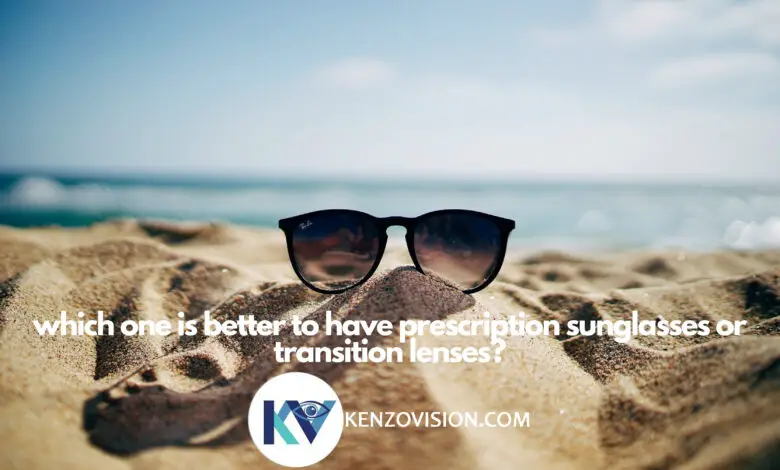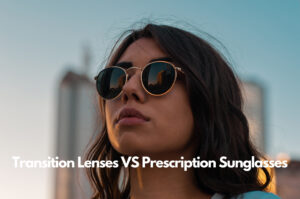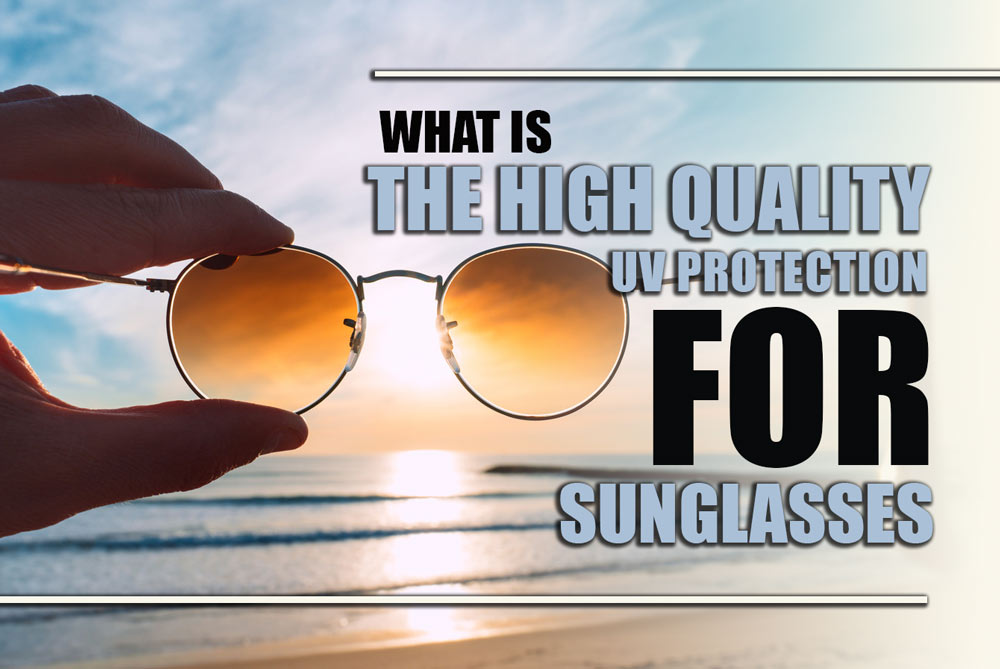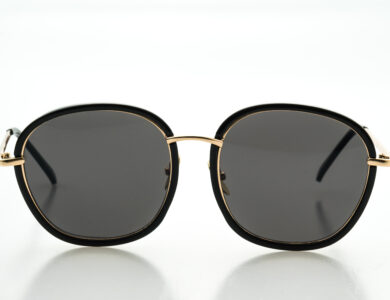
Transition lenses are more budget-friendly and more convenient but prescription sunglasses have more features and are more stylish. Ultimately, you decide which one is better to have prescription sunglasses or transition lenses.

Transition Lenses and Prescription Sunglasses: what’s the difference?
Transition lenses and prescription sunglasses offer unique benefits for vision correction and eye protection in varying light conditions. Transition lenses, also known as photochromic lenses, automatically adjust their tint based on UV exposure, transitioning from clear indoors to dark outdoors.
They provide the convenience of eliminating the need to switch between glasses and adapting to changing light levels while ensuring UV protection. On the other hand, prescription sunglasses have a fixed tint to shield the eyes from bright sunlight, glare, and harmful UV rays.
They offer immediate tint customization and come in various styles and colors to suit individual preferences. While transition lenses excel in adaptability, catering to those who frequently move between indoor and outdoor environments, prescription sunglasses provide targeted sun protection and style versatility for specific lighting conditions or activities.
Understanding the differences between transition lenses and prescription sunglasses helps individuals choose the eyewear solution that best meets their vision needs, lifestyle preferences, and fashion choices for enhanced comfort and eye health.

Transition Lenses VS Prescription Sunglasses
Style
Prescription sunglasses come in many shapes and forms and are usually more stylish than optical frames that you can get transition lenses on. So, if you are elegant, you prefer to wear prescription sunglasses.
Cost
The cost of a good pair of prescription sunglasses and optical glasses with transition lenses is similar. Still, you must remember that when you buy glasses with transition lenses, you will save money because you don’t need to purchase two different glasses for different occasions.
Convenience
In the case of convenience, transition lenses are the winner because being convenient and easy to use is among their primary purposes. With transition lenses, you don’t have to carry a pair of glasses and change in different environments.
UV protection
There’s no difference in the power of transition lenses and prescription sunglasses in protecting your eyes from the sun, visual disturbances, and harmful UV rays. But remember that because transition lenses are more convenient, you will always have them around to protect your eyes.

Disadvantages of transition lenses
Being too reactive
Sometimes, especially in the winter, your transition lenses can become too reactive, change color very fast when in contact with light, and have problems changing back in a reasonable amount of time. This is because the reactions will occur slower in the winter.
Compatibility for everyday activities
Sometimes, transition lenses are incompatible with everyday situations; for example, driving with them may be challenging because your windshield darkens your view, making your transition lenses less effective.
Less optional
Most transition lenses do not have polarizing capabilities, so while they protect your eyes from harmful UV rays, if you are set on having a pair of glasses with polarized lenses, we suggest you buy a pair of prescription sunglasses.
UV protection importance
UV protection is crucial for maintaining the health and safety of our eyes and skin. Prolonged exposure to sun ultraviolet (UV) radiation can lead to a range of eye conditions, including cataracts, pterygium (a growth on the eye’s surface), and macular degeneration, which can impact vision and overall eye health.
UV rays can also cause damage to the delicate skin around the eyes, leading to premature aging and an increased risk of skin cancer. By wearing UV-protective sunglasses and sunscreen, we can shield our eyes and skin from the harmful effects of UV radiation, reducing the risk of developing eye disorders and skin damage.
Investing in quality sunglasses with UV protection ensures clear vision and comfortable eyes and plays a crucial role in preserving long-term eye health and maintaining youthful, healthy skin. Prioritizing UV protection is a simple yet powerful way to safeguard our eyes, enhance our well-being, and enjoy the outdoors safely.
FAQs: Sunglasses vs. Transition Lenses
Q: What are the main differences between sunglasses and transition lenses?
A: Sunglasses and transition lenses serve the common purpose of providing eye protection from harmful UV rays and bright light. Sunglasses are traditional tinted lenses offering constant UV protection and reduced glare in varying light conditions.
On the other hand, transition lenses are photochromic lenses that automatically adjust their tint based on the level of UV exposure, transitioning from clear indoors to dark outdoors.
Q: Which one is more convenient for varying light conditions?
A: Transition lenses offer convenience for individuals who frequently transition between indoor and outdoor environments.
They adapt to varying light levels, ensuring optimal visibility without switching between regular glasses and sunglasses. However, some users prefer sunglasses’ immediate and customizable tint options for specific light conditions or fashion preferences.
Q: How do sunglasses and transition lenses compare regarding UV protection?
A: Sunglasses and transition lenses provide UV protection, shielding the eyes from harmful ultraviolet rays. Sunglasses offer consistent UV protection, while transition lenses adjust their tint to block UV rays based on the light intensity, ensuring continued protection in changing environments.
Q: Can transition lenses replace sunglasses completely?
A: While transition lenses offer UV protection and adaptive tinting, some users may prefer traditional sunglasses for specific activities or style preferences.
Sunglasses provide immediate tint adjustment and are available in various styles, lens colors, and specialized coatings, offering a customized experience that transition lenses may not fully replicate.
Q: How do lifestyle and preferences influence the choice between sunglasses and transition lenses?
A: Lifestyle factors, personal preferences, and visual needs play a significant role in selecting sunglasses and transition lenses. Individuals with active outdoor lifestyles may favor sunglasses for their immediate tint adjustment and style versatility.
At the same time, those who value convenience and seamless light adaptation may opt for transition lenses to simplify their eyewear needs.
choosing between sunglasses and transition lenses depends on individual preferences, lifestyle requirements, and visual comfort.
Both options offer UV protection and glare reduction, with sunglasses providing immediate tint customization and style variety, while transition lenses offer convenience and adaptability in changing light conditions. Understanding your unique needs and preferences will guide you in selecting the eyewear solution that best suits your lifestyle and enhances your visual experience.
| Feature | Transition Lenses | Prescription Sunglasses |
| Style | Typically, it is more basic compared to prescription sunglasses. | Offer a wide range of stylish options to choose from. |
| Cost | Cost-effective in the long run as there’s no need for multiple pairs of glasses. | Similar initial cost but may require separate pairs for different needs. |
| Convenience | It is convenient, eliminating the need to switch between glasses in different environments. | Requires changing between regular glasses and prescription sunglasses based on lighting conditions. |
| UV Protection | Both provide effective UV protection against harmful rays. | Equally offers protection, ensuring eye safety from UV exposure. |
| Disadvantages of Transition Lenses: |
| 1. Being too reactive: Transition lenses can become overly responsive in changing light conditions, especially in the winter, which may lead to slow transitions or difficulty reverting to clear lenses. |
| 2. Compatibility for everyday activities: Transition lenses may pose challenges in specific situations like driving, where the lenses can darken due to the windshield, affecting vision clarity. |
| 3. Fewer options: Most transition lenses lack polarizing capabilities, so if polarized lenses are a priority, prescription sunglasses may be a better choice for optimal UV protection and vision quality, especially in environments with intense glare. |




